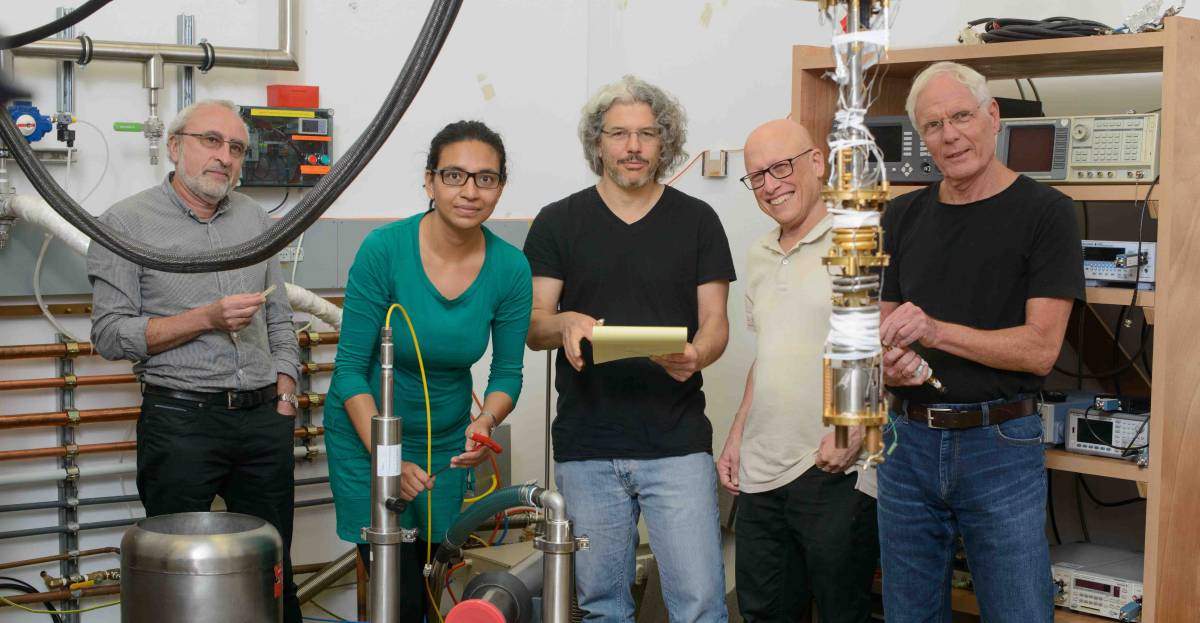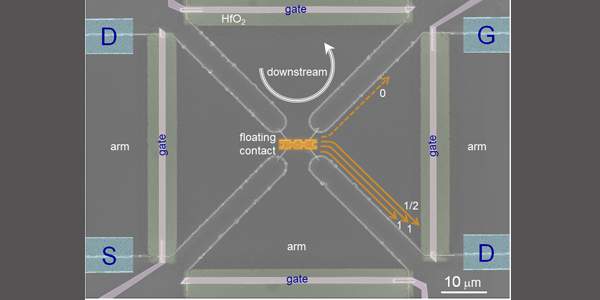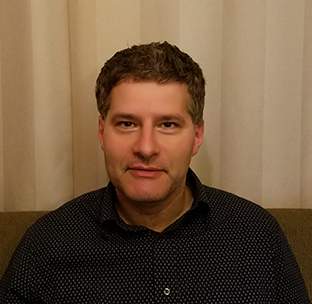Are you a journalist? Please sign up here for our press releases
Subscribe to our monthly newsletter:

At the Weizmann Institute of Science, a unique group of theoretical and experimental physicists recently collaborated to investigate whether the quantum behavior of electrons in certain exotic systems occurs in predictable ways. Their results suggest that even in the world of “imaginary” quantum particles, the reality of materials that are nearly pure may have some profound effects on their properties.
The researchers investigated the “quantum Hall effect,” which takes place when an electric current that is confined to two dimensions is exposed to a magnetic field running perpendicular to the plane of the current. The electrons in such a current are said to exist in a topological state – that is, running just on the edge of a two-dimensional plane.
Although the Hall effect has been known for over a century, researchers began to discover the quantum aspects of this phenomenon only around three decades ago. These involve a special behavior of Hall resistance: It obtains a series of quanticized values – that is, values that are discrete and non-continuous. These values repeat themselves in experiments with different materials and in different conditions, with an accuracy of one in a billion.

Soon enough, however, physicists discovered that things are not always as neat as they first seemed. One of the more intriguing examples is the fractional quantum Hall effect, or the fractional charge. Although in general, electrons all carry identical charges, some topological systems are capable of behaving as though they carry charges that are a fraction of that of a standard electron. These are called “imaginary” or “quasi-particles”, and the experimental demonstrations of their existence have raised a number of questions.
To ask what these particles are, we first need to understand that all particles are said to be divided into two types: fermions and bosons (named for Enrico Fermi and Satyendra Nath Bose, respectively). Electrons are considered to be fermions – particles of matter. A photon, in contrast, is a boson, because it carries only energy. But the imaginary particles in a quantum Hall system break that dichotomy in surprising ways, producing new types of behavior that do not fit either definition.
According to predictions, one of the more exotic behaviors of these particles may be “non-Abelian.” If these quasi-particles could be shown to be non-Abelian, this could have implications, among other things, for their use in quantum computing based on topological states. Such particles would, according to the predictions, be relatively stable (they would have a high degree of coherence), since their interactions with the environment would be weak. But at the same time, that weak interaction would make it hard to study them in experimental settings.
A group of physicists in the Condensed Matter Physics Department of the Weizmann Institute of Science, including postdoctoral fellow Dr. Mitali Banerjee, Prof. Moty Heiblum, Prof. Yuval Oreg, Prof. Ady Stern and Staff Scientist Dr. Vladimir Umansky, working with Prof. Dimitri (Dima) Feldman of Brown University in the US, succeeded in demonstrating that one quantum Hall state is, indeed, non-Abelian. Umansky, who is a world champion at producing the ultra-pure materials needed for such experiments, created the crystalline semi-conductor material gallium arsenide. In the Weizmann Institute’s Submicron Center, the material was then cooled to a few thousandths of a degree above absolute zero. For this experiment, Banerjee and Heiblum developed a special means of measuring the thermal conductivity of the electrons that participate in the effect. A particular temperature gradient would be a sign of a non-Abelian state. Or, as Heiblum explains, they would find “integer quantization” of the conductivity in Abelian particles, while the fractional particles, if truly non-Abelian, would exhibit “fractional quantization.”

As the researchers had predicted, the particles in their system exhibited “fractional thermal conductance,” indicating they were non-Abelian. But, to their surprise, these non-Abelian particles did not behave quite as expected, suggesting they were a different type of non-Abelian particles than those in the theoretical models.
The theoreticians – Oreg, Stern, Dr. David Mross and research student Gilad Margalit – set to work to find an explanation for the surprising result. Previous calculations had been carried out under the assumption that the system would be ideal and its materials pure down to the last atom and crystal structure. But, as it turned out, even in the purest system impurities still exist, and these can produce inhomogeneity between different parts of the same material. In other words, there is no such thing as a completely perfect material.
When the scientists revised their calculations to allow for some non-ideal level of purity, they obtained predictions that fit the results. Indeed, it appears that even though perfection in the material was thought to be a condition for creating non-Abelian states, the imperfections may actually be necessary for it to occur.
Prof. Moty Heiblum's researrch is supported by the Joseph H. and Belle R. Braun Center for Submicron Research. Prof. Heiblum is the incumbent of the Alex and Ida Sussman Professorial Chair of Submicron Electronics.
Prof. Yuval Oreg's research is supported by the Maurice and Gabriella Goldschleger Center for Nanophysics, which he heads. Prof. Oreg is the incumbent of the The Lady Davis Professorial Chair of Experimental Physics.